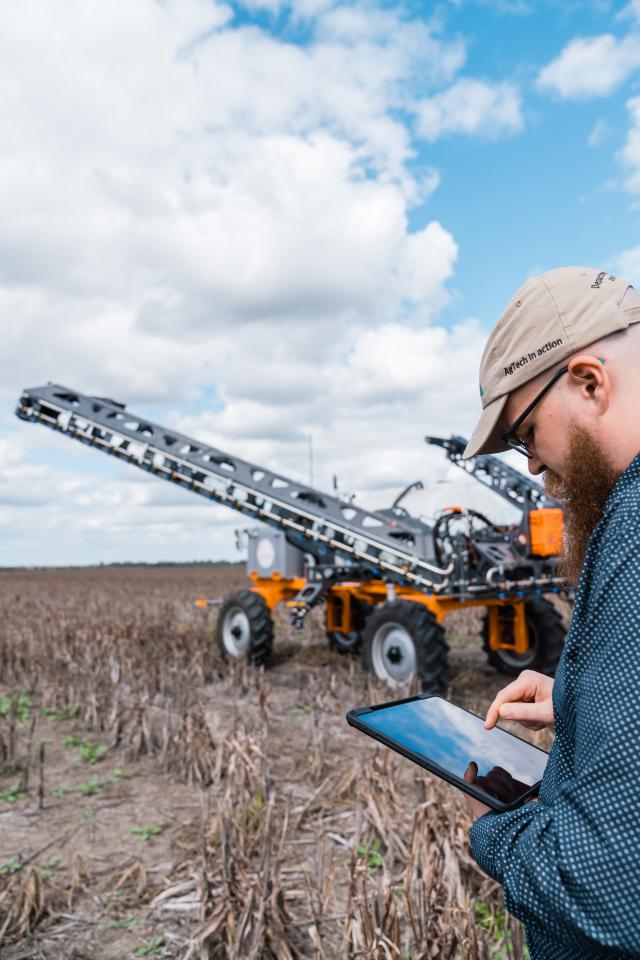Aussie farmers will one day have two types of farms – their actual farms and virtual ones.
While the concept of virtual farms may conjure up images of the old video game FarmVille, where users grew crops and raised livestock, simulation will become reality in the not-too-distant future.
This ties into the rapid development and uptake of agtech, including robotics, automation and AI.
Agtech in Australia has grown exponentially in the past decade, with a raft of new innovations emerging to improve efficiency, profitability and sustainability for businesses in the agricultural sector.
With Agtech Month and National Agriculture Day falling in November, it’s a good time to have a look at how agtech is helping agribusinesses innovate and grow – both now and into the future.
Since the Agtech and Logistics Hub opened nearly two-and-a-half years ago, we’ve worked with some incredible innovators who have developed everything from cutting-edge traceability platforms to micro-irrigation tech.
With the agtech sector thriving, the potential to improve yields, efficiency and profitability is huge.
Here are the types of agtech set to transform the agriculture sector:
Traceability: As more consumers want to know how their food gets from paddock to plate, the demand for traceability is strengthening. By facilitating the tracking of a product right through the agrifood supply chain, traceability allows growers, producers and businesses to validate the quality, provenance and safety of food products. There are companies developing some incredible traceability platforms and we’ve just seen Meat & Livestock Australia (MLA) awarded a $22.5 million federal grant to build a new national livestock traceability platform. Traceability can be of huge value to agribusinesses, helping them with compliance and enabling them to back up their marketing claims or showcase their point of difference via a simple QR code.
IoT sensors: We’re seeing huge growth in IoT (Internet of Things) sensors being used in the sector. IoT sensors analyse crops, temperature, humidity, water, and soil conditions, providing farmers with real-time data to make planting and harvesting decisions. They can also be used to track livestock and equipment, and even detect the presence of pests. IoT devices are paramount for precision farming, allowing for the use of real-time data to increase yields while reducing inputs such as water and fertiliser.
AI driven-automation, robotics and machine learning: This trio of technologies is going to be instrumental in advancing Australia’s agricultural sector, enabling agribusinesses to compete globally by boosting productivity and speed to market. We’re already seeing the development of fully autonomous tractors using advanced AI, as well as agricultural robots being used for crop production. Farmers are also using machine learning to collect and interpret vast amounts of data to assist with farming automation and on-farm decision making.
Sustainability: A big question right now is how agribusinesses adopt better and safer environmental standards while still being competitive on the global market. We’re seeing a lot more agtech coming into this space, including AI modelling to predict what carbon is being captured. There’s also ‘circular economy’ tech that can take waste or by-products from farms and make them into a useable input for agriculture or other industries. This ncludes tech that can turn manure into fertiliser.
Across the sector, we are starting to get a full picture of what the farms of the future are going to look like – more virtual, autonomous and precise.
However, there are some challenges.
One is agtech adoption, with many farmers struggling to find the reliable digital connections required for digital technologies and/or the skills to operate them.
Another is commercialisation. While Australia is known for its agtech research, funding and scaling the technologies can be a challenge.
We also need to ensure the industry is collaborating. While it’s great so much tech is emerging, the tech needs to work together in a way that doesn’t require a farmer to install 20 apps on their phone.
These are challenges we’re working to overcome, with agtech required to play a major role in meeting Australia’s bold goal of lifting its farm gate value from a forecast $80 billion in 2023-24 to $100 billion by 2030.






